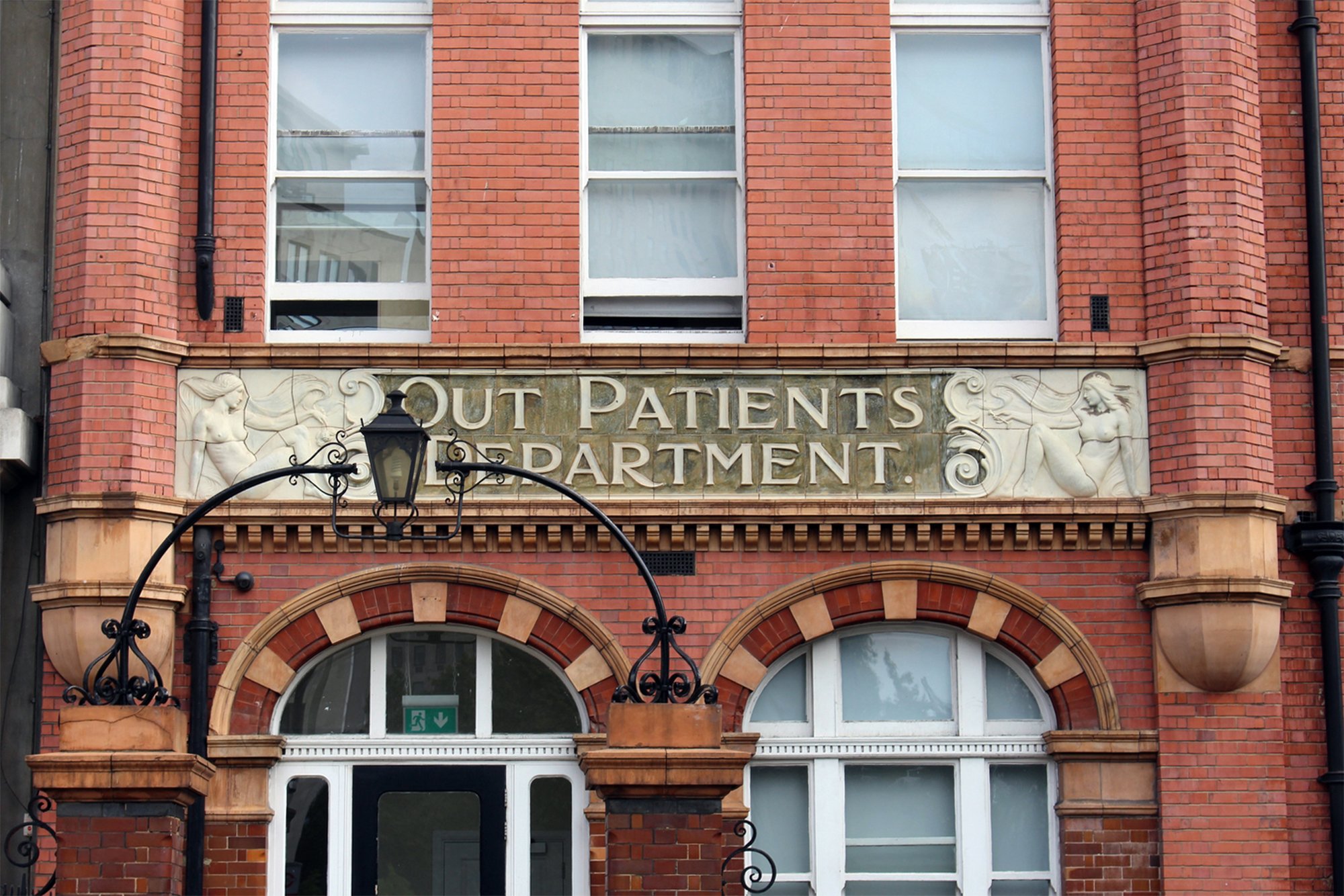Buildings For Women As Patients
28 Keldgate, Beverley, West Yorkshire 1749, designed by James Moyser and built by Thomas Wrightson
Listed Grade II in 1950
Set into the pediment of these red brick almshouses for elderly women is a very fine coloured Rococo cartouche of arms, its frame formed by scrolls and palm leaves. This rests on a tablet which records that hospital was endowed by the late Anne Routh Moore with £100 per annum 'for the maintenance of 12 poor old women of the parishes'.
Marylebone Road, London 1889-90 by WC Habershon and F Fawkner
Listed Grade II in 1987
The Samaritan Hospital for Women was founded in 1847 to provide free healthcare to women unable to afford private medical treatment. The present building dates from 1889-90. It is a bold, eclectic classical composition in red brick and terracotta with a tall pedimented centrepiece flanked by lower wings with bow windows. The hospital eventually closed in the 1990s.
29 Great Ancoats Street, Manchester 1899 by William Sharpe
Listed Grade II in 1998
This women's shelter and rescue home was built for the Wesleyan Methodist Church, Central Hall Mission, as a gift from a Mr James Scarlett. It was designed to provide non-institutional support for women, and specifically for domestic servants, thought to be at risk in the adjacent industrial district of Ancoats. There was both temporary and semi-permanent residential accommodation as well as training and recreational facilities, notably a ground floor coffee tavern providing an alcohol-free environment for socialising.
The building is in an Arts and Crafts style with Vernacular Revival detailing. It is constructed of red brick, with decorative banding in buff terracotta, and with a jettied gable to the narrow frontage. The ground floor coffee shop retains some decorative tile-work to the stall risers and a tiled canopy above. Some windows on the side elevation retain their leaded lights and Art Nouveau stained glass panels.
29 and 30 Soho Square, Westminster, London 1909-10 recasing by Adams and Holden of two earlier houses, No 30 of late seventeenth-century origins, No 29 a rebuild of 1867-9
Listed Grade II in 1987
The Hospital for Women began in Red Lion Square, Holborn, and was the first hospital to offer its services to all women, regardless of social class. It moved to a former house in Soho Square, no 30, in 1851; in 1865 it expanded into no 29, which was rebuilt by the architect EL Bracebridge at this time. The matt glazed white faience and stucco façade and dormered green slate mansard were added in 1909-10. The parapet is inscribed with the words 'The Hospital for Women'.
Leavy Greave Road, Sheffield, South Yorkshire 1878 by John Dodsley Webster
Listed Grade II in 1995
This hospital for women replaced an older building with just nine beds and was funded by Thomas Jessop, a wealthy steelworks owner. The new building had 57 beds, and an addition to the west in 1902 provided a further hundred. It is in a Gothic Revival style in brick with ashlar dressings and slate roofs.
Waterloo Road, London 1903-5 by MS Nicholson
Listed Grade II in 1980
The Royal Waterloo Hospital was founded in 1816 as a dispensary for children in the City of London. The institution moved to this site, on the corner of Waterloo Bridge Road and Stamford Street in Lambeth, in 1823.
Its name was altered in 1852 to the Royal Infirmary for Children and Women, on receipt of an annual bequest on condition that the hospital admitted inpatients and treated women.
The current Lombardic Renaissance-style hospital dates from a rebuilding of 1903-5. It features a Doulton-ware porch from the local ceramic manufactory, and the three-tiered terracotta loggia bears characterful lettering announcing the title and purpose of the institution.
New Bridge Street, Newcastle-upon-Tyne 1826 by John Dobson
Listed Grade II in 1971
This former maternity hospital was built on land given by the Corporation of Newcastle, and John Dobson, the city's leading architect, gave his services for free; other expenses were met by public subscription. The building is sandstone ashlar with a low-pitched dark slate roof. It has a Tudor-arched surround to the central door and a corbelled oriel above with Perpendicular tracery.
-
Places Associated With Health Pioneers
Four pioneers of women's healthcare and the buildings connected to them.
-
Buildings For Training Nurses, Doctors… and Mothers!
A history of four buildings where women were trained to treat and care for patients.





